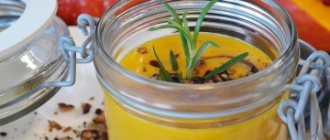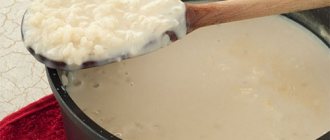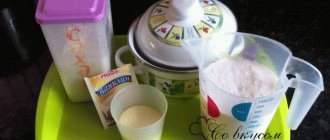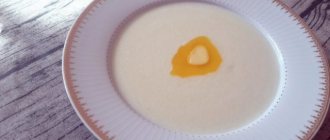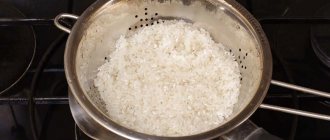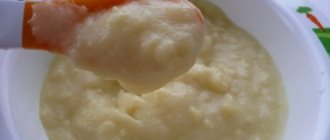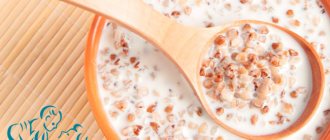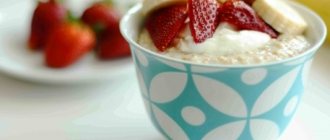By the age of 1, many changes occur in a child’s body. His first teeth appear, his digestion changes, and chewing skills develop. The enzyme component of digestion changes, allowing it to cope with solid food, which is why the child is being rebuilt. A new 4-times-a-day diet appears, new products are added, and their quantity increases. With the advent of new menu components, nutrition becomes more complete. An invariable component of the children's menu is porridge, and their quantity grows with the child. However, not only the cereals themselves are important, but also the methods of preparing them, because most likely your child has already managed to form an attitude towards certain dishes and craves new tastes. Below, we will consider what new cereals can be introduced to children over 1 year old, as well as various methods of preparing them.
What are the benefits of cereals?
Cereals are a valuable food product that is a source of complex carbohydrates. Products in this group are a source of energy and also give you a feeling of satiety. Cereals also contain proteins, fats and carbohydrates, along with vitamins and minerals. There are a lot of microelements in cereals, such as calcium, magnesium or iron.
Each type of cereal has its own benefits and characteristics. For example, buckwheat is considered the most valuable due to the absence of gluten and high content of proteins, fats, iodine, iron and other microelements. In the group of gluten-free cereals, rice and corn occupy an important place. Rice contains beneficial components to a lesser extent, but serves as an excellent nutritional component of the diet and is well absorbed by the intestines. Corn grits are healthier, they contain components useful for the structure of the body, they are as easily digestible as rice, but they take a long time to cook.
Oatmeal ranks second in terms of value for the body of a one-year-old child. At the same time, not only oatmeal itself is useful, but also other by-products based on this cereal. It is worth noting the abundance of vegetable fats, coupled with phosphorus, potassium, vitamins E and B and a number of other useful components. Due to the gluten contained in pure oatmeal, porridge may be difficult to digest, so it is worth purchasing processed oat products.
Barley and pearl barley are a product of barley processing. The abundance of microelements and satiety of the product makes it an excellent alternative for a child’s lunch or morning menu. Among the disadvantages, it is worth noting that they are difficult to digest, so there should not be too much of such cereals in the diet.
Finally - semolina. Despite popular opinion, such cereals are less useful than the options listed above. Undoubtedly, semolina contains enough microelements and vitamins, plus it contains a lot of protein and starch, so the child gets full very quickly. But some advantages can also be significant disadvantages. For example, frequent consumption of semolina leads to rapid weight gain, and gluten can cause intestinal upset.
However, not all cereals are equally healthy. Some parents give children millet from 1 or 1.5 years of age. This cereal is not on our list. Since it can be quite harmful for the baby. First of all, millet is a fairly coarse grain, so it is difficult for a 1-year-old child to chew it. This feature also leads to digestive problems. Finally, after heat treatment, a very modest amount of vitamins and microelements remains.
Corn
The product is difficult to prepare - it often burns, so it must be cooked with the addition of water.
For 1 unit of cereal, take 2 units of water and 2 milk. The cereal is filled with water and cooked with constant stirring for 20–30 minutes. Then, when the water boils away, the thick porridge begins to gurgle, milk is poured in, you can turn off the porridge after boiling. At the end you can add salt, butter and sugar. The porridge should sit for at least 10 minutes after cooking. Corn porridge is combined with dried fruits, grated fresh apple, canned peaches, and pineapples.
What porridges can be introduced from one year onwards?
Cereals are an integral part of children's diets, but in order for them to be beneficial, they should be introduced only at a strictly designated time. So the first porridge for a child, at the age of about 6 months, becomes buckwheat, rice or corn. This choice is due to the absence of gluten, which means the new food will be easier to digest for a fragile digestive system. Next, oatmeal is added as complementary food.
Porridge for a one-year-old child may already contain gluten and be coarser than before. At this age, the baby begins to be given semolina porridge. It is perfect as a nutritious meal for a fast-growing body. Also at this age you can start giving heavily boiled wheat porridge.
In some cases, after one year of age, children can begin to be given barley and pearl barley porridge. In total, the baby’s diet contains at least 8 different cereals. Thus, the child has access to almost all basic cereals, which are easily digestible and contain many useful components. This is also a plus for mom, who has plenty to choose from when creating a menu.
Note. If you are giving your child porridge for the first time, then it makes sense to use a ready-made product for this. The ready-made or soluble mixture has a delicate texture, is prepared from high-quality cereals and therefore fully complies with sanitary standards, plus it is easily accepted by the baby’s intestines. The exception is products with flavoring additives; it is better not to buy such products, as they can become a potential source of allergic reactions.
Product benefits
Oatmeal is in the ranking of the healthiest cereals. Its composition is rich in protein, which is probably the reason for another name for oatmeal - “Hercules”, since it gives a lot of strength and health. There are B vitamins. Necessary components for the development of the bone apparatus are calcium and phosphorus. It is important and convenient that everything useful for strengthening the body is “collected” in one product. Thanks to the combination of these substances, eating oatmeal becomes the basic rule of a healthy diet.
Oatmeal is rich in fiber, which helps speed up metabolism. All cereals contain carbohydrates, but oatmeal contains more of them than other cereals, so it is considered the best source of energy.
For children, who have a higher activity level than adults, oatmeal can be a major “power accumulator.” For a mother, this is an important reason to include it in the baby’s menu. The benefit of oatmeal is its ability to improve blood composition: reduce cholesterol levels, strengthen the immune system. But, it is worth remembering that this is a gluten-containing cereal, so if your child has protein intolerance, introduce buckwheat into the diet.
Oatmeal is most often consumed for breakfast; the product is very filling and high in calories. A breakfast option that will remove all toxins and eliminate discomfort in the intestines is a serving of Hercules with a glass of freshly squeezed orange juice. These two products complement each other well because they are sources of phenol.
The calorie content of oatmeal with water is 380 kcal/100 g. For a child, this is just right.
Children's porridge recipes
Properly prepared porridge, first of all, must be completely cooked; this is why it is worth familiarizing yourself with the cooking time:
- buckwheat – 30–45 min,
- millet – 45 min,
- oatmeal 20–25 min,
- rice 30–40 min,
- semolina 15 min.
These are general values; if the cereal has previously undergone any processing, then the cooking time is reduced and will be indicated on the package.
Buckwheat
To prepare, we will take the standard proportions for preparing porridge, that is, 1 tablespoon of cereal flour and a glass of water/vegetable broth/milk. Flour should be poured with half a glass of water and let sit for about 5 minutes. Then add the remaining liquid and put on fire (you can add a little salt). Cook the porridge over low heat until thickened. After cooking, oil is added to the porridge.
Rice porridge
Just like for buckwheat porridge, we will use flour; you can make it yourself by grinding washed and sorted grains in a coffee grinder. The proportions are still the same - 5 grams of flour (1 tablespoon) per 100 grams of liquid.
If a child actively chews, then there is no point in turning porridge into flour. Therefore, take 2 tablespoons of rice and cook in 2 glasses of water. After 40+ minutes of cooking, the rice will be cooked enough. As a last resort, if this consistency is not suitable, grind the finished porridge with butter in a blender.
Corn porridge
This time the proportions are slightly changed, we will need 1 glass of water per 2 tablespoons of flour. We put the flour not in cold, but in boiling water, then wait until the liquid boils and quickly mix everything until smooth. Cook the dish for about 15 minutes, and then let it sit a little.
Advice. Corn grits should be cooked immediately before eating. Cooled or cold cornmeal porridge is dry and hard.
Oatmeal porridge
For the recipe, take a glass of milk, two glasses of water and 2 tablespoons of Hercules porridge. Like corn grits, this grits is placed in boiling water. Cook the oatmeal over low heat for about 20 minutes, then remove and add milk. If you need to achieve a more uniform consistency, then rub the boiled porridge through a sieve and only then add butter and milk.
Semolina porridge
Take a glass of liquid (milk or water), a tablespoon of cereal, 1⁄2 tsp butter. Bring the liquid to a boil and pour a spoonful of cereal into it. Immediately stir the porridge thoroughly and continue stirring until the cereal is cooked. Turn off the heat, add oil and let the dish sit for 15 minutes.
As you can see, preparing most cereals is very simple and does not take much time. The presented recipes are quite simple, so to diversify the taste of the dish after cooking, you can add pureed fruits, dried apricots, prunes to the porridge, you can also mix the porridge with meat or vegetable puree. Don't forget that you can add a little salt as you get older. Another way to diversify the taste of porridge is to cook it together with vegetables, for example, porridge with pieces of pumpkin or carrots may please your baby much more than usual.
Remember! All porridge additives that you use in cooking should be previously tested separately from the porridge to eliminate the risk of allergies to unfamiliar products.
Oatmeal for a one-year-old child
To prepare this porridge you will need:
- 200 ml. milk
- 2 tbsp. oatmeal
- 5 g sugar
- 5 g butter
Pour milk into a small saucepan and bring to a boil. Add oatmeal and reduce heat to low. The porridge cooks for 5-7 minutes, but do not forget to stir it periodically. When the porridge is cooked, turn off the heat, cover the pan with a lid and leave for 5 minutes. At the end you can add sugar and butter. This oatmeal recipe is perfect for a one year old child.
Useful tips
- Regardless of the type of cereal, it must be carefully sorted before cooking.
- If the cereal contains pests or a pronounced foreign odor, it is not suitable for cooking.
- All cereals (except crushed) should be thoroughly washed before cooking.
- Stainless steel utensils are best suited for cooking, since porridge burns in enamel containers, and aluminum releases toxins.
- The first prepared porridge should be heavily boiled and cooked in water or vegetable broth.
- Immediately before cooking, the cereal can be ground in a coffee grinder, so it will cook faster.
- Instant cereal is boiled for about 3 minutes, then left covered for up to 10 minutes. When the baby begins to actively chew for cooking, you can use the instructions on the package and simply steam the porridge.
- It is not advisable to boil milk for a long time, so it is added to the dish after cooking. You can also use milk diluted 1k1 with water, and after absorbing the liquid, cook the porridge over very low heat.
- Oil is added only at the end of cooking.
Rice
Rice porridge goes well with jam, fresh and dried fruits, nuts, vegetables, and fish.
For children, you should choose regular round white unparboiled rice.
Before cooking, rice should be thoroughly rinsed until the water is no longer cloudy. Then cook with water in a ratio of 1:2, cook over low heat, stirring constantly, as this porridge often burns. When the rice is boiled (after 15–20 minutes), you should add milk in an amount equal to water. When the porridge boils, add butter, a little salt, you can sweeten it with sugar or honey and close the lid to infuse. You can cook porridge only in water, in this case we cook at the rate of 1:4. At the end, if the water has boiled away too much and the porridge has become too viscous, you can add more milk or water and bring to a boil. Rice porridge can be combined with meat, fish, jam, stewed vegetables, nuts, raisins and other dried fruits.
In a slow cooker: cook for 30 minutes on milk porridge mode.
Millet
To cook delicious millet porridge, millet, milk and water should be added in a ratio of 1:1:4, respectively.
Prepares within 30 minutes. There is no point in soaking it overnight. For a unit of cereal you should count one unit of milk and 4 units of water. The washed cereal is poured into boiling water, everything is cooked for about 15 minutes (until the water boils away). Then milk is added and simmered over low, barely noticeable heat for another 15 minutes. The porridge should have a homogeneous consistency, with well-swollen grains.
In a multicooker: millet porridge is cooked for 1 hour in the milk porridge mode, then left for another half hour in the heating mode.
Manna
The porridge cooks very quickly and does not burn. Unlike other porridges, it is prepared exclusively with milk. Dairy-free semolina porridge tastes watery and unpleasant.
To prepare semolina porridge for one mug of milk you will need 2 tablespoons of cereal. A little water and milk are poured into the bottom of the pan, then semolina is poured in in a stream. To make the porridge without lumps, pour the cereal into cold milk; if you like lumps, you can pour the cereal in a thin, thin stream while simultaneously stirring into the boiling milk. To completely eliminate lumps, you can dilute the cereal in a small amount of cold water and immediately put the mixture in a saucepan. Cook for 2-4 minutes, stirring constantly, the porridge often “runs away”. Be sure to add butter, salt and sugar. You can eat the porridge immediately after it has cooled. Children eat especially well semolina porridge prepared with pumpkin.
In a slow cooker: cook the semolina for 8 minutes with the lid open.
Pearl barley
The porridge is cooked in water for a long time. Proportions – 1:3. The washed pearl barley is poured with cold water in a ratio of 1:4 for several hours. This water is drained and another is added, on which the porridge will be cooked. Boil the porridge for at least 50 minutes. If desired, you can add a little milk at the end. After an hour, butter or vegetable oil is added to make the cereal soft. Then it is better to leave it for 30 minutes under a lid in a warm place. Pearl barley porridge goes very well with meat and meat dishes.
Porridge cooked with milk is less digestible, so it is not recommended for feeding children.
In a slow cooker: the pearl barley is cooked in the same proportions, in the mode for buckwheat or stewing. If the cereal was pre-soaked, cook for 1 hour; if not, about 2 hours.
